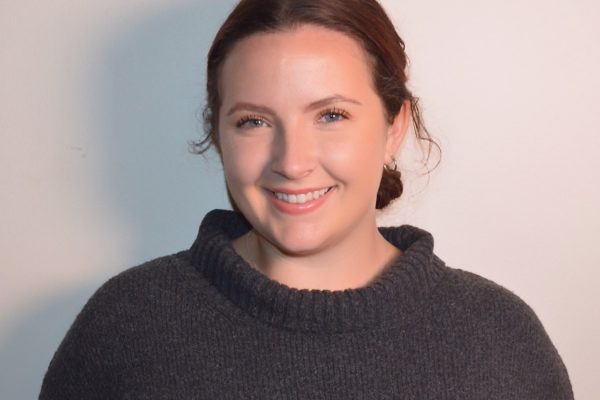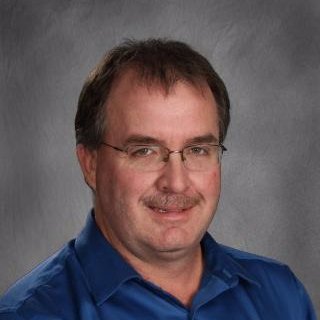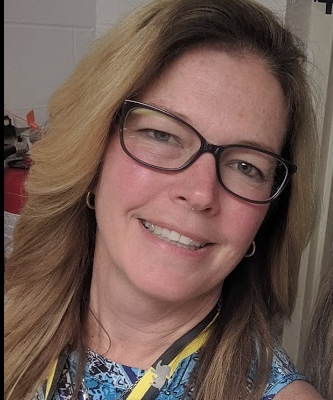by Diane Horvath
Five years into the development of Blake Middle School’s Blaker Makerspace, we are still evolving as #MIP Makers-In-Progress. The space is changing as we add materials and expand instruction, and the students and teachers continue to work toward a maker mindset.
It is amazing to consider that it all started by simply clearing out a corner of the LMC, adding materials for building (including lots of cardboard), and adding electronics along with craft supplies, tools, and a 3D printer. Once the physical space was organized and filled, Design Thinking was introduced to students and teachers. The vision was to provide new learning opportunities through experimentation and creation that would help to foster collaboration and flexibility in thinking. In the Blaker Makerspace, these opportunities to create in real time also helped to demonstrate that within the learning process, failure often leads to the improvement of ideas and designs.
At the same time, my role as the Technology Integration Specialist began to morph into leading this change. What I soon found out is that success equals the willingness of fellow educators to collaborate, connect and learn from one another both inside and outside of my district. Luckily, in the Boston-area, there are so many opportunities to make connections and build your own MakerED Professional Learning Network (PLN) through offerings from MassCUE, MIT Edgerton Center and the community on twitter, which truly have been invaluable.
At the 2019 MassCUE Fall Conference, I teamed up with Kathleen Caprio, 6th Grade English Teacher, to share our #MIP Makers-In-Progress experiences at a Playground session. We wanted to highlight the BlakerMakerspace vision and our collaborative efforts in student learning by:
 Making sure students have access to a variety of materials, tools, resources for circuits and coding to stretch their thinking and ideas. The 6th grade Whimsical Poetry Exploration class, led by Kathleen and Marjorie Heim, does a nice job of fully integrating all of these components with students collaboratively writing poetry and then constructing visual, interactive representations.
Making sure students have access to a variety of materials, tools, resources for circuits and coding to stretch their thinking and ideas. The 6th grade Whimsical Poetry Exploration class, led by Kathleen and Marjorie Heim, does a nice job of fully integrating all of these components with students collaboratively writing poetry and then constructing visual, interactive representations.-
- Chain Reaction Poems integrating Little Bits circuits and
Shrinky Dink Flashlight Popsicle sticks. - Marble Run Poetry
- Six Word Memoirs on LED Circuit Tiles
- Chain Reaction Poems integrating Little Bits circuits and
- Trying to reach as many students as possible by finding pockets in the schedule or content where there is some flexibility and relevance. You will see this with every 8th grader learning to design 3D prints as a result of a team effort of the 8th grade cluster leaders, Jason Heim, Jillian Shaw and Erin Kearney and making this happen through their Engineering and Math lab times. This learning experience later evolved into creating 3D models for their upcoming Washington DC trip matched with audio recordings as a way to preview the historical locations and daily agenda.
- Offering small entry points for teachers who are not able to dedicate several class periods to a larger project.
- 8th Grade English teacher, Seth Hellerstein, has purposely approached integrating making by using small, ongoing work times for developing characters and story settings using 3D printing and virtual reality tools. This approach allows time to explore, design and eventually reiterate their creations using these same tools.
- 8th Grade Math teacher, Susan Bycoff, has branded her makerEd integration as Tiny Retro Math- with the same approach of quick, mini projects to generalize concepts and show how math relates to everyday life, such as creating student-version of classic board games to demonstrate inequalities and making fortune tellers to practice vocabulary to name a few.
- Bringing in the softer side of making through fabrics and fibers also gives students a way to experience making with different materials, tools and machines to demonstrate their learning. Believe or not, both machine and
 embroidery/hand sewing have been very popular with all students. The past two years, the Spanish classes hand sew their sugar skulls using color embroidery floss & creative stitches. Also, the Medfield’s community of knitters and crocheters join forces for the #Yarn4Hope project, which installs yarn creations to bring awareness & support for September’s Suicide Prevention Month.
embroidery/hand sewing have been very popular with all students. The past two years, the Spanish classes hand sew their sugar skulls using color embroidery floss & creative stitches. Also, the Medfield’s community of knitters and crocheters join forces for the #Yarn4Hope project, which installs yarn creations to bring awareness & support for September’s Suicide Prevention Month.
- Celebrating the Hour of Code/STEAM has definitely made an impression on students and teachers. It is an event that gives time to promote the Makerspace with all of the valuable resources available and to hopefully spark new ideas as well as a willingness to rethink, redesign, or remix their students learning.
It truly takes teamwork inside and out to make this happen, and to develop the Maker mindset while understanding that it is a constant work-in-progress! Having a school culture of taking risks and that failure really is learning emphasizes the importance of having these opportunities for students in our school. These messages are strongly advocated by Nat Vaughn, Principal, who has helped to establish and sustain the Makerspace at Blake Middle School. But, I am also fortunate to be able to grow as an educator through opportunities to share at events like MassCUE’s Fall Conference, and by continually staying connected to other makerminded educators in the MassCUE Makerspace SIG group.
Diane Horvath is a Technology/MakerEd Integration Specialist at Thomas Blake Middle School in the Medfield Public School District. She is a 2018 MassCUE PathFinder Award recipient, a member of the MassCUE Fall Conference Committee and Makerspace SIG, and will be co-leading the Playground at the 2020 MassCUE Fall Conference. Feel free to reach out to her on Twitter and Instagram @techmonstah
 Print this post
Print this post



